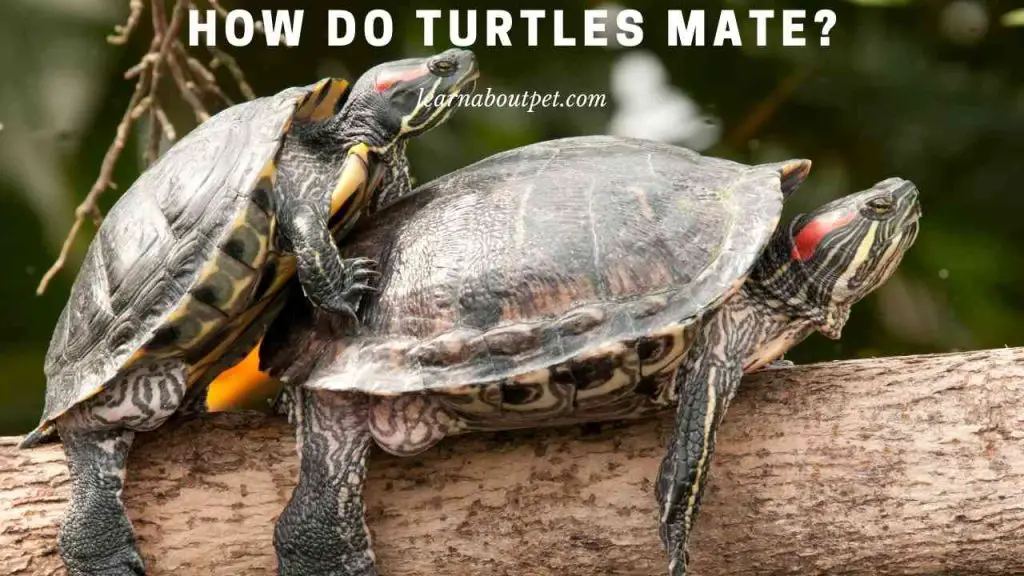One of the most frequently asked questions about turtles is the one on how they mate. Sometimes, we get this question from people who are considering breeding turtles. At other times, we get this question from individuals who are just curious. Read on, for answers.
How do turtles mate? Turtle mating starts with the male turtle courting the female. Then the male turtle mounts the female. The turtles thereafter twist their tails, so that the penis in the male turtle’s cloaca gets into the tract in the female turtle’s cloaca. The male inseminates the female, to complete the process.
After this, the female turtle will find a nesting place, where she lays the now fertilized eggs (3-6 weeks after mating). She digs the egg nest with her hind legs. Then she lays the eggs there. Eventually some of them hatch into young turtles.

How Do Turtles Reproduce?
To put the how do turtles mate question in its proper perspective, it is important for us to first understand how turtles reproduce. That is because the mating act is part of turtle reproduction.
So it is while discussing reproduction how do turtles mate question arises.
As it turns out, turtles are among the animals that reproduce sexually.
The offspring gets some genetic material from its male parent and some from its female parent: which is what sexual reproduction is all about.
Do Turtles Mate?
There are folks who express interest in knowing whether turtles actually mate. This is because, to some people, turtles don’t look like the sorts of animals that are capable of mating.
Therefore before launching into a discussion on how do turtles mate, it is important for us to establish whether, indeed, these creatures mate in the first place. Only then can we proceed to discuss how turtles mate.
The truth of the matter is that turtles do mate. Their reproduction depends on mating between male and female turtles.
This applies for all types of turtles. The answer to the question on how do turtles breed is always to the effect that they breed by mating.
True, a female turtle may lay eggs even without mating with a male. But such eggs are always infertile (unless she had stored semen from a previous mating session).
For a female turtle to lay fertile eggs that are actually capable of hatching, she needs to mate.
Therefore if you are trying to figure out how to breed pet turtles, then you need to know that it will have to entail mating.
Ultimately, for turtles mating is essential if at all reproduction is to take place.
With this background information, we can now proceed to explore the question on how do turtles mate?
How Do Turtles Mate?
Turtle mating behavior is complex. The actual turtle mating process can be visualized as having three major phases. And it is quite draining for both the male and female turtle.
In the first phase, the male turtle courts the female. This normally starts with the male turtle sniffing around the female turtle’s cloaca.
Then it gets to a point where the male turtle becomes more aggressive: trying to tickle the female turtle’s face, trying to bite on the female turtle’s flippers and trying to bite the female turtle’s neck.
The mating process only proceeds to the next phase when the female turtle gives approval. If she walks away, it means rejection for that particular male. If she continues hanging around, it means that the male can continue with the courtship – until he gets approval.
The next phase of the mating process is where the male turtle mounts the female. This entails the male turtle actually getting on top of the female turtle’s shell. He then supports himself there, using the claws on his flippers.
The final phase of the mating process is where the male and female turtles twist their tails. When they do this, the male turtle’s penis (which is in his cloaca) gets to enter the female turtle’s tract (which is in her cloaca).
With the male turtle’s penis in the female turtle’s tract, all that remains is for insemination to take place. Semen flows from the male turtle’s penis to the female turtle’s tract.
It is in the course of this phase that you may hear turtle mating noise or turtle mating sound (which is somewhat similar to tortoises mating noise).
So, in a nutshell, that is the answer to the question on how do turtles mate (or how do turtles do it)?
How Do Box Turtles Mate?
Box turtles mating behavior is similar to what we see in most other turtles.
It starts with the male turtle courting the female turtle. This is mostly through provocative behaviors: like sniffing on the female’s cloaca, attempting to bite the female’s flippers and attempting to bite the female’s neck.
Then the male box turtle mounts the female.
Thereafter, the male box turtle gets its penis (which is inside its cloaca) into the female’s tract (which is inside the female’s cloaca). Thereafter, the male box turtle gets to inseminate the female, to complete the mating ritual.
One may ask, when do box turtles mate? And the answer is that, in the wild, they usually mate during the spring or in early summer.
Another question may come up: how long do box turtles mate? The answer is that the entire mating ritual in box turtles can take hours. The courtship phase can be particularly long: before the male box turtle gets permission to mount the female. As long as 7 hours.
And even when the male gets to mount, it can take a while for adequate insemination to take place in order to fertilize all the eggs in the female. At the very least, it can take 5-15 minutes of the male box turtle being on top of the female.
How Do Red Eared Slider Turtles Mate?
In answering the question on how do red eared sliders mate, we need to have some insight on where their reproductive organs are located.
The reproductive organs in red eared slider turtles are located beneath their tails, in their cloacae. The organs in question here are the penis for the male, and the tract for the female.
So, given that their reproductive organs are in their cloacae, how do turtles mate red eared slider?
This is how red eared slider turtles mate: by twisting their tails. When they twist their tails, the male red ear sliders expose their penises (which are in their cloacae, beneath their tails).
And when they twist their tails, the female red ear sliders expose their tracts – which are also in their cloacae, beneath their tails.
The penises then get to enter the tracts, after which insemination takes place.
Of course, for all this to happen, the male box turtle needs to mount the female.
And for the male red ear slider to get a chance to mount the female, it has to go through a long courtship process.
But in the end, the male gets to mount the female. Then they twist their tails. The penis in the male red ear slider enters the female’s tract, after which insemination takes place.
So if you happen to encounter a pair of red eared slider mating turtles, you need to know that this is what is happening.
At this point, someone may ask: can a red eared slider mate with a painted turtle? Or to put it differently, can painted turtles mate with red eared sliders?
The answer is yes. After all, these are turtles that have a lot in common. And when they get a chance, they do interbreed.
How Do Loggerhead Turtles Mate?
Loggerhead turtles are in the category of sea turtles. That being the case, how do loggerhead turtles reproduce? The answer is that loggerhead turtles reproduce by mating.
They typically mate in the water. This entails the female turtle swimming horizontally, and the male turtle mounting while it (the female turtle) is swimming horizontally.
The mounting is preceded by courtship.
After mounting the female, the male loggerhead turtle gets its penis (which is inside its cloaca) into the female’s tract (which is also inside the female’s cloaca).
Then the male proceeds to inseminate the female, so that she can subsequently lay fertile eggs.
Clearly, the answer on how do loggerhead turtles mate is similar to that for how do slider turtles mate. Or more specifically, how do red-eared slider turtles mate.
This is because for all turtles, mating behaviors have a lot of uniformity. Indeed, even a discussion on African sideneck turtle mating behaviors would still be along these same lines.
But it is worth noting that this is only for turtles. If we were to take it further and ask, can turtles and tortoises mate, the answer would be vastly different. This is because although they look alike, turtles and tortoises are in different families, genus and species.
Even beyond breeding matters, a simple question like how long can a tortoise live without a heat lamps vs how long a turtle can live without the same would draw vastly different responses.
Turtles and tortoises may look alike. But there are also some very important differences between them.
As for loggerhead turtles, their mating behavior is similar to that for most other types of turtles.
How Do Painted Turtles Mate?
Painted turtles are among those that live in shallow fresh waters. They mate in the water.
The male painted turtle courts the female. Then he proceeds to mount the female. Thereafter, they twist their tails, giving the male a chance to get its penis (which is in its cloaca) inside the female’s tract.
The mating is only complete when the male gets to inseminate the female (with enough semen to fertilize all her eggs).
So if you are trying to figure out how to breed painted turtles, that is how you should expect the mating aspect to go.
How Do Snapping Turtles Mate?
As with most other turtles, for snapping turtles mating is a complex affair. It entails the male inseminating the female.
For that to happen, the male has to mount the female. Then they have to twist their tails in a manner that allows the male snapping turtle’s penis to enter the female turtle’s tract. This is tricky, as both organs are inside the respective turtle’s cloacae.
Nonetheless, once the male snapping turtle’s penis is inside the female’s tract, insemination takes place – after which the female gets to lay fertile eggs.
One may ask, at what time of year do snapping turtles mate? And the answer is that snapping turtles typically mate in the spring. That is when temperatures rise, and daylight hours increase – which are the optimal conditions for mating in turtles.
How Do Pet Turtles Mate?
Mating in pet turtles is, in many ways, similar to mating in wild turtles. The only difference is in the fact that pet turtles may not have any special mating season.
In the wild, turtle mating season depends on light and temperature conditions. This is why the mating season is typically in spring, when daylight hours and temperatures are increasing.
But pet temperatures live under controlled light and temperature conditions. So they may start mating any time.
As for the actual mechanics of mating, they are similar for both pet and wild turtles. The mating entails the male courting, then mounting and thereafter inseminating the female.
So for anyone with the question on how do turtles mate in a tank (as most pet turtles live in a tank), that is how they get to do it.

By the way, if you search for how do turtles mate diagram drawings (or how do turtles mate images), you will notice that they typically depict the mounting phase. This is where the male turtle is on top of the female.
That is because most people view this as the most crucial and defining phase of the mating process.
In actual fact though, the courtship phase is also critical. If the male doesn’t court the female successfully, it doesn’t get a chance to mount and subsequently inseminate.
Still, the mounting phase is the one that is easiest to depict in pictures, so this is understandable. Indeed, even a search for pics of sea turtles mating will typically depict the male mounting the female.
How Often Do Turtles Mate?
A discussion on how do turtles mate will be incomplete if we don’t touch on the frequency with which they do it.
Within a single mating season, female turtles may mate with more than one male.
That is one of the most interesting turtle mating facts. This they may do to ensure that they get enough semen to fertilize all their eggs, and to end up with progeny that is genetically diverse (and which therefore has better potential for survival).
Therefore in a single mating season, both the males and females mate multiple times, often with diverse partners.
How Long Do Turtles Mate?
Another important aspect to look at, in the course of a discussion on how do turtles mate, is that of how long they mate.
The whole mating process – from courtship to insemination – can take hours. That is because the male only gets to mount the female when it is accepted, so to speak, in courtship. And this can take as long as 7 hours.
So, in answering the question on how many hours do turtles mate, we may say as many as 7.
How long the male turtle actually stays on top of the female also varies from pair to pair.
There are some where the male may stay on top for as few as 5 minutes.
There are others where the male may stay on top for as many as 15 minutes, or even more. Some get stuck for hours actually.
So that also answers the question on how fast do turtles mate?
…From all this, it should be clear that answering the question on how do turtles mate in Minecraft is very different from answering the same on how they do it in real life.
It is the same as trying to answer the question on how do terrapins mate or how do tortoises mate, with reference to turtles. The answers are bound to be radically different, seeing that these are different types of animals, with different mating behaviors.
All in all, the turtle mating process can, in its entirety, take as many as 7 hours. That is from courtship to the actual insemination.
When Do Turtles Mate?
This, in other words, is a question on what time of year do turtles mate?
In the wild, turtles typically mate right after hibernation. That is at the start of spring – when temperatures rise and daylight hours increase.
In captivity, where temperature and light conditions are controlled, turtles may start mating at any time of the year.
One may also want to know, what age do turtles mate from? And the answer is that the age of sexual maturity varies from one type of turtle to the next. It also varies from male to female turtles.
For instance, for male red ear sliders, the age of sexual maturity may be 2 to 4 years. But female red ear sliders may only attain sexual maturity between 3 and 5 years.
So there is a male female turtle difference, when it comes to sexual maturity age. And that answers the question on at what age do red eared sliders mate?
On the other hand, it may not be until they are 5 years old that box turtles attain sexual maturity. So there is a turtle breed difference, when it comes to sexual maturity age.
Where Do Turtles Mate?
Often, alongside the how do turtles mate question arises this one – on where turtles mate.
As it turns out, some turtles mate on land. And other turtles mate in water.
The turtles that spend most of their time in water typically also mate in water. So if you have been having the do turtles mate in water question, the answer is ‘yes’.
And the answers to the questions on how do turtles mate on land and how do turtles mate in water (or how do aquatic turtles mate) are essentially the same. Even the question on how do sea turtles mate is within this paradigm.
That is because whether they mate on land or in water, the process entails courting, mounting and insemination.
So for a sea turtle mating takes place right in the sea. And for land turtles mating takes place on land.
This should also answer the question on how sea turtles reproduce or how do sea turtles breed? They mate right in the sea. The female swims horizontally, and the male proceeds to mount it from that position.
How Can You Tell If Turtles Are Male Or Female?
This discussion on how do turtles mate is essentially a discussion on turtle reproduction. It therefore makes sense, in the course of it, to deal with the question of how to tell the difference between male and female turtles.
In actual fact, the difference between male and female turtles is rather subtle.
Whether it is the red eared slider male female difference you are seeking to know about or it is painted turtle boy or girl difference you are seeking to know, you should understand that what sets them apart is subtle.
The easiest way to tell if turtles are male or female is by looking at their tails. In males, the tails are long and thick. But in females, the tails are short and thin.
Male turtles’ bottom shells are concave, while females’ are convex. So in answering the are turtles male or female question, this is a useful hint.
Those are some of the easiest ways to tell if turtles are male or female.
Therefore if you are trying to figure out how to tell sex of red eared slider turtles (or how to tell red slider turtle gender), those are the things to check. Similarly, for African sideneck turtle male or female differences are mainly along those lines.
All in all, that is how to tell difference between male and female turtles or how to tell between male and female turtles.
But it is worth mentioning that for a baby turtle male or female differences may be too subtle to notice. The gender of turtles only tends to become clear as they grow.
How Do You Know When Turtles Are Mating?
Often, the people who pose the how do turtles mate question also want to know how to tell when turtles are mating.
In most cases, you can only tell that turtles are mating if you find the male turtle on top of the female.
So should you find the male turtle mounting the female, you would know that it is probably as part of mating.
But you can also check more subtle courting behaviors to tell if turtles are about to mate. For instance, if you find the male sniffing the female’s cloaca. Or if you find the male trying to bite on the female’s flippers or on her neck.
One may ask, at this point, how do turtles mate with their shells?
And the answer is in the fact that their sexual organs are in their cloacae. And the cloacae are beneath their tails. So the shells don’t really interfere with their mating. The male turtle just mounts the female, then they twist their tails to give access to their respective cloacae.
Do Turtles Mate For Life?
Turtles typically mate from the time they attain the age of sexual maturity, right up to nearly the time they die. So in that regard, they ‘mate for life’.
But turtles don’t have lifelong partners with whom they mate all through. So, with regard to monogamy, turtles don’t mate for life.
This applies for both sea and land turtles. Do sea turtles mate for life? The answer is that they mate all their lives – but with no fixed lifelong partners. The same applies for land/freshwater turtles.
How Do You Stop Turtles From Mating?
This is how to stop turtles from mating: by ensuring that the males stay away from the females. That is the best strategy.
Otherwise if you have the males and the females in contact, and it is during the mating season, they will inevitably try to mate. Therefore it is best to just keep them separately, if you don’t want them to mate.
Final Verdict – How Do Turtles Mate
How do turtles mate? The turtle mating process starts with a courtship ritual. If the male courts the female successfully, he gets to mount her. Then the turtles twist their tails in a manner that allows the male’s penis (which is in his cloaca) to enter the female’s tract (which is also in her cloaca). Thereafter insemination takes place.
After insemination, it may take 3-6 weeks for the female to lay eggs, which will now be fertile, and therefore capable of hatching.

Note that even if your female turtle doesn’t get a chance to mate, she will still lay eggs. But these eggs will be infertile, and therefore incapable of hatching.
Turtles can mate in land and some turtles like painted turtles mate in water.
As a pet lover, make sure to learn about pet more and give your pet turtle a good and comfortable life!

Welcome to Learn About Pet. My name is Rajkumar Ravichandran and I love all pets, travel, and amazing food. I write about my passion and personal experience caring for multiple pets in this blog! ❤️
Post Disclaimer
DISCLAIMER: THIS BLOG OR WEBSITE, "Learn About Pet", DOES NOT PROVIDE YOU WITH MEDICAL ADVICE AND IS NOT A SUBSTITUTE FOR MEDICAL ADVICE. ALWAYS GET IN TOUCH WITH YOUR PERSONAL VETERINARIAN AND USE INFORMATION HERE AS GENERAL ADVICE.
The information, including but not limited to, text, graphics, images and other material contained on this website are for informational purposes only. No material on this site is intended to be a substitute for professional veterinary advice, food recommendation, diagnosis, or treatment. Always seek the advice of your veterinarian or other qualified health care provider with any questions you may have regarding a medical condition or for pet food related questions.







